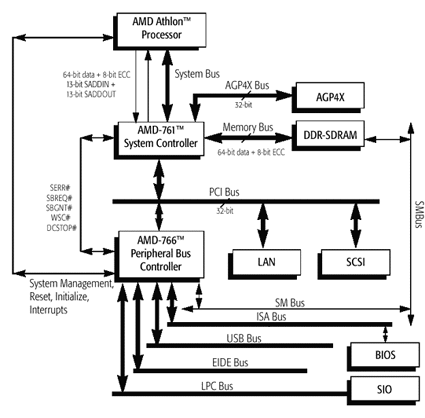Als nieuwspostings gemodereerd zouden kunnen worden door bezoekers zou dit waarschijnlijk een "-1 Dubbelpost" worden, maar na zeven reviews kan deze er ook nog wel bij ![]() . AMD 760 is het onderwerp van de dag, en dus kon ook FiringSquad niet achterblijven met een review van de nieuwe chipset. Er wordt gekeken naar ZD Winbench, OfficeBench, SiSoft Sandra, 3DMark 2000, Unreal Tournament, MDK2 en (hoe kan het ook anders) Quake3.
. AMD 760 is het onderwerp van de dag, en dus kon ook FiringSquad niet achterblijven met een review van de nieuwe chipset. Er wordt gekeken naar ZD Winbench, OfficeBench, SiSoft Sandra, 3DMark 2000, Unreal Tournament, MDK2 en (hoe kan het ook anders) Quake3.
De Thunderbird 1,2GHz DDR wordt niet alleen vergeleken met zijn SDRAM tegenhanger, maar ook met 2 Durons, te weten een overgeclockte 600MHz versie (800MHz DDR), en een normale Duron 800MHz uitgerust met PC133 geheugen. Uit de tests blijkt dat ook de Duron een flinke boost krijgt van de extra bandbreedte van het DDR RAM. De uiteindelijke conclusie is niet zo enthousiast, ze raden aan af te wachten hoe het DDR gebeuren zich verder ontwikkelt, de drivers beter worden en de moederborden volwassener worden:
What's our ultimate recommendation? Hold out for a few months and let DDR motherboards and memory settle down a bit. While the performance advantage is noticeable, it isn't a remarkable difference. Wait a little longer and see what kind of DDR products are in the pipeline. Wouldn't it be disappointing to pick up a shiny new DDR motherboard only to find out that DDR 'boards with multiplier adjustment are just a month or so away?
If you do pick up a 760 motherboard you certainly won't be disappointed with its performance. With backward compatability with existing 200MHz processors (in PC1600 mode) we're sure this is a route many of you will take.
 |

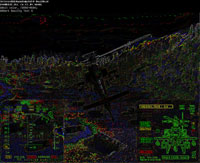


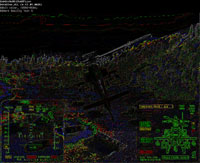

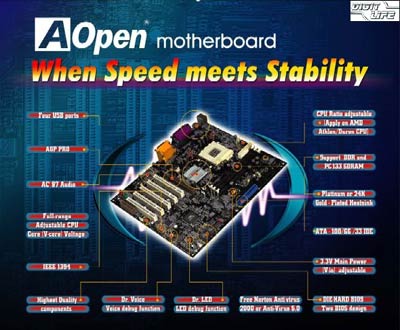
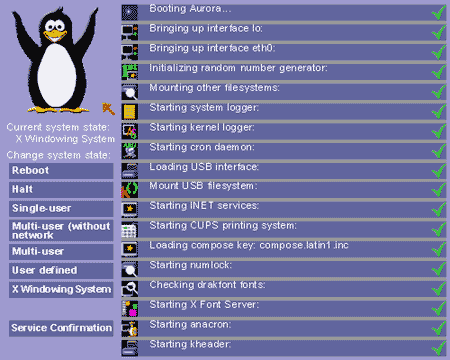

 Het is nog steeds onduidelijk of 200MHz FSB Thunderbirds met een simpele multiplier tweak op 266MHz FSB gebruikt kunnen worden, maar Anand suggereert wel zoiets in zijn review. 266MHz FSB exemplaren zijn trouwens herkenbaar aan een C in het Ordening Part Numer. Oude 200MHz FSB Athlons hebben een B:
Het is nog steeds onduidelijk of 200MHz FSB Thunderbirds met een simpele multiplier tweak op 266MHz FSB gebruikt kunnen worden, maar Anand suggereert wel zoiets in zijn review. 266MHz FSB exemplaren zijn trouwens herkenbaar aan een C in het Ordening Part Numer. Oude 200MHz FSB Athlons hebben een B:

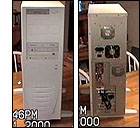 Although everything has been going fairly smoothly, the ride is about to get a little bumpy. One thing
about this case that really bugged me was the hard drive rack. When I took this case apart (down
to taking the plastic feet off), I found out that the hard drive rack is nearly impossible to mount
without a drive in it. And when there is a drive inside the rack, it's basically impossible to mount it
back in the case. I ended up sliding the motherboard back out to make room for the rack.
Although everything has been going fairly smoothly, the ride is about to get a little bumpy. One thing
about this case that really bugged me was the hard drive rack. When I took this case apart (down
to taking the plastic feet off), I found out that the hard drive rack is nearly impossible to mount
without a drive in it. And when there is a drive inside the rack, it's basically impossible to mount it
back in the case. I ended up sliding the motherboard back out to make room for the rack.
/i/1304498402.png?f=fpa)
 De analyse die door Morgan en Andersen wordt gemaakt is niet nieuw, maar
hun eindconclusie verschilt wel van eerdere rapporten die voorspelden dat
de consument de rekening voor de UMTS-veilingen ging dragen. Volgens de
onderzoekers zou de situatie op de 3G dienstenmarkt zo competitief zijn dat
operatoren alles op alles zullen zetten om zoveel mogelijk klanten te werven,
bijvoorbeeld door lage tarieven te hanteren. "Het feit dat de bedrijven zoveel
betaalden voor de licenties betekent dat zij een groot aantal gebruikers van
3G-diensten nodig hebben", zegt Declan Lonergan, een analist bij
researchfirma The Yankee Group. "Als er geen consumentenmarkt komt,
kunnen deze bedrijven niet overleven", benadrukt hij.
De analyse die door Morgan en Andersen wordt gemaakt is niet nieuw, maar
hun eindconclusie verschilt wel van eerdere rapporten die voorspelden dat
de consument de rekening voor de UMTS-veilingen ging dragen. Volgens de
onderzoekers zou de situatie op de 3G dienstenmarkt zo competitief zijn dat
operatoren alles op alles zullen zetten om zoveel mogelijk klanten te werven,
bijvoorbeeld door lage tarieven te hanteren. "Het feit dat de bedrijven zoveel
betaalden voor de licenties betekent dat zij een groot aantal gebruikers van
3G-diensten nodig hebben", zegt Declan Lonergan, een analist bij
researchfirma The Yankee Group. "Als er geen consumentenmarkt komt,
kunnen deze bedrijven niet overleven", benadrukt hij. Although the PL133 does not top the Intel i810 chipset in business
performance, the marginal loss is easily made up by the PL133's 3D
performance. Another advantage of the PL133 is cost. The PL133 is expected to
cost anywhere from $30-40 cheaper that the Intel i810. This may not sound
like a whole lot, but when your talking about PCs that are sub $800, it becomes
a major issue.
Although the PL133 does not top the Intel i810 chipset in business
performance, the marginal loss is easily made up by the PL133's 3D
performance. Another advantage of the PL133 is cost. The PL133 is expected to
cost anywhere from $30-40 cheaper that the Intel i810. This may not sound
like a whole lot, but when your talking about PCs that are sub $800, it becomes
a major issue.
 If this reference system is representative of what we can expect from 760 chipset-based systems, AMD has a bright future, especially if they and their partners can keep prices down on all of the components involved. The 760 chipset reportedly has pricing around $40 each, but don’t expect AMD to sell them for long. AMD is only planning on selling the 760 until VIA and other chipset makers can make their own versions in quantity.
If this reference system is representative of what we can expect from 760 chipset-based systems, AMD has a bright future, especially if they and their partners can keep prices down on all of the components involved. The 760 chipset reportedly has pricing around $40 each, but don’t expect AMD to sell them for long. AMD is only planning on selling the 760 until VIA and other chipset makers can make their own versions in quantity.
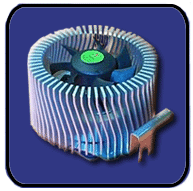

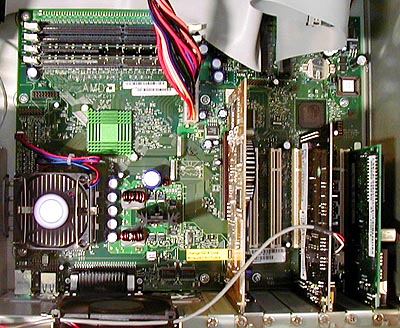
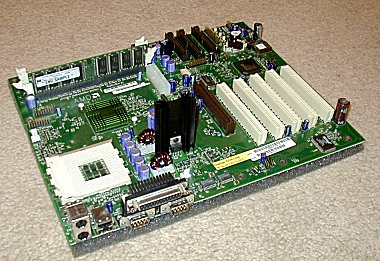
 )
) 1)
1) )
)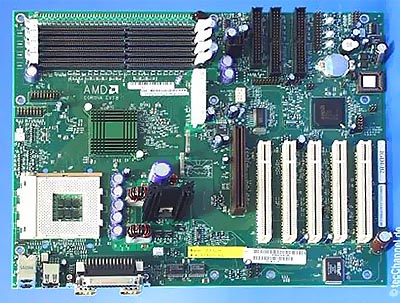
:strip_exif()/i/1299845111.gif?f=fpa)
 "We've been testing Pentium-IV systems for next month's high-end Ultimate
Gaming Machine shootout, and the early numbers are provacative. A 1.5 GHz
Pentium-IV is about 44% faster than the fastest 866 MHz Pentium-III in this
month's system roundup, using 3D WinBench's Processor Test - which tests CPU
performance handling 3D data. But that same Pentium-IV system was only about
11% faster than a Thunderbird Athlon 1.1 GHz on the same test. Given Pentium
IV's 36% clock advantage, my guess is that Athlon will fare well against
Pentium-IV, given equal clock rates. More on this next month."
"We've been testing Pentium-IV systems for next month's high-end Ultimate
Gaming Machine shootout, and the early numbers are provacative. A 1.5 GHz
Pentium-IV is about 44% faster than the fastest 866 MHz Pentium-III in this
month's system roundup, using 3D WinBench's Processor Test - which tests CPU
performance handling 3D data. But that same Pentium-IV system was only about
11% faster than a Thunderbird Athlon 1.1 GHz on the same test. Given Pentium
IV's 36% clock advantage, my guess is that Athlon will fare well against
Pentium-IV, given equal clock rates. More on this next month."
 DDR memory is an evolutionary new technology that increases peak data throughput to the processor by up to 100 percent compared to its predecessor, Synchronous Dynamic Random Access Memory (SDRAM), at comparable costs to SDRAM solutions. AMD's DDR platform solution, which includes the award-winning AMD Athlon processor, provides the foundation to continue AMD's leadership position in supplying high-performance solutions for the performance PC space.
DDR memory is an evolutionary new technology that increases peak data throughput to the processor by up to 100 percent compared to its predecessor, Synchronous Dynamic Random Access Memory (SDRAM), at comparable costs to SDRAM solutions. AMD's DDR platform solution, which includes the award-winning AMD Athlon processor, provides the foundation to continue AMD's leadership position in supplying high-performance solutions for the performance PC space.
